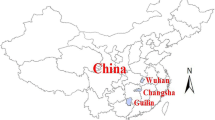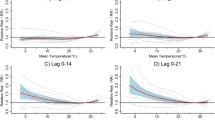Abstract
Objectives
To investigate whether a sudden temperature change between neighboring days has significant impact on mortality.
Methods
A Poisson generalized linear regression model combined with a distributed lag non-linear models was used to estimate the association of temperature change between neighboring days with mortality in a subtropical Chinese city during 2008–2012. Temperature change was calculated as the current day’s temperature minus the previous day’s temperature.
Results
A significant effect of temperature change between neighboring days on mortality was observed. Temperature increase was significantly associated with elevated mortality from non-accidental and cardiovascular diseases, while temperature decrease had a protective effect on non-accidental mortality and cardiovascular mortality. Males and people aged 65 years or older appeared to be more vulnerable to the impact of temperature change.
Conclusions
Temperature increase between neighboring days has a significant adverse impact on mortality. Further health mitigation strategies as a response to climate change should take into account temperature variation between neighboring days.




Similar content being viewed by others
References
Barnett AG (2007) Temperature and cardiovascular deaths in the US elderly: changes over time. Epidemiology 18(3):369–372
Basu R (2009) High ambient temperature and mortality: a review of epidemiologic studies from 2001 to 2008. Environ Health 8:40
Bell ML, O’Neill MS, Ranjit N, Borja-Aburto VH, Cifuentes LA, Gouveia NC (2008) Vulnerability to heat-related mortality in Latin America: a case-crossover study in Sao Paulo, Brazil, Santiago, Chile and Mexico City Mexico. Int J Epidemiol 37(4):796–804
Bouchama A, Knochel JP (2002) Heat stroke. N Engl J Med 346(25):1978–1988
Carder M, McNamee R, Beverland I, Elton R, Cohen GR, Boyd J, Agius RM (2005) The lagged effect of cold temperature and wind chill on cardiorespiratory mortality in Scotland. Occup Environ Med 62(10):702–710
Cheng J, Xu Z, Zhu R, Wang X, Jin L, Song J, Su H (2014) Impact of diurnal temperature range on human health: a systematic review. Int J Biometeorol. doi:10.1007/s00484-014-0797-5
Curriero FC, Heiner KS, Samet JM, Zeger SL, Strug L, Patz JA (2002) Temperature and mortality in 11 cities of the eastern United States. Am J Epidemiol 155(1):80–87
Epstein PR (2005) Climate change and human health. N Engl J Med 353(14):1433–1436
Faergeman O (2008) Climate change, disease and public health. Ugeskr Laeger 170(35):2667–2668
Gasparrini A (2011) Distributed lag linear and non-linear models in R: the package dlnm. J Stat Softw 43(8):1–20
Gasparrini A (2013) Distributed lag non-linear models in R: the package dlnm. http://cran.r-project.org/web/packages/dlnm/vignettes/dlnmOverview.pdf. Accessed 17 Mar 2014
Gasparrini A, Armstrong B, Kenward MG (2010) Distributed lag non-linear models. Stat Med 29(21):2224–2234
Goldberg MS, Gasparrini A, Armstrong B, Valois MF (2011) The short-term influence of temperature on daily mortality in the temperate climate of Montreal Canada. Environ Res 111(6):853–860
Green RS, Basu R, Malig B, Broadwin R, Kim JJ, Ostro B (2010) The effect of temperature on hospital admissions in nine California counties. Int J Public Health 55(2):113–121
Guo Y, Barnett AG, Yu W, Pan X, Ye X, Huang C, Tong S (2011) A large change in temperature between neighbouring days increases the risk of mortality. PLoS One 6(2):e16511
Guo Y, Punnasiri K, Tong S (2012) Effects of temperature on mortality in Chiang Mai city, Thailand: a time series study. Environ Health 11:36
Guo Y, Barnett AG, Tong S (2013) Spatiotemporal model or time series model for assessing city-wide temperature effects on mortality ? Environ Res 120:55–62
Huang C, Barnett AG, Wang X, Tong S (2012) Effects of extreme temperatures on years of life lost for cardiovascular deaths: a time series study in Brisbane Australia. Circ Cardiovasc Qual Outcomes 5(5):609–614
IPCC (2013) Summary for policymakers. In: Climate change 2013: the physical science basis. Contribution of Working Group I to the Fourth Assessment Report of the Intergovernmental Panel on Climate Change. Cambridge University Press, Cambridge
Kenney WL, Hodgson JL (1987) Heat tolerance, thermoregulation and ageing. Sports Med 4(6):446–456
Kjellstrom T, McMichael AJ (2013) Climate change threats to population health and well-being: the imperative of protective solutions that will last. Glob Health Action 6:20816
Lim YH, Park AK, Kim H (2012) Modifiers of diurnal temperature range and mortality association in six Korean cities. Int J Biometeorol 56(1):33–42
Lin H, Zhang Y, Xu Y, Xu X, Liu T, Luo Y, Xiao J, Wu W, Ma W (2013) Temperature changes between neighboring days and mortality in summer: a distributed lag non-linear time series analysis. PLoS One 8(6):e66403
McGeehin MA, Mirabelli M (2001) The potential impacts of climate variability and change on temperature-related morbidity and mortality in the United States. Environ Health Perspect 109(Suppl 2):185–189
Schneider A, Schuh A, Maetzel FK, Ruckerl R, Breitner S, Peters A (2008) Weather-induced ischemia and arrhythmia in patients undergoing cardiac rehabilitation: another difference between men and women. Int J Biometeorol 52(6):535–547
WHO (2008) (World Health Organization) Protecting Health from Climate Change—World Health Day 2008
Yang J, Ou CQ, Ding Y, Zhou YX, Chen PY (2012) Daily temperature and mortality: a study of distributed lag non-linear effect and effect modification in Guangzhou. Environ Health 11:63
Yang J, Liu HZ, Qu CQ, Lin GZ, Zhou Q, Shen GC, Chen PY, Guo Y (2013) Global climate change: impact of diurnal temperature range on mortality in Guangzhou, China. Environ Pollut 175:131–136
Zanobetti A, O’Neill MS, Gronlund CJ, Schwartz JD (2012) Summer temperature variability and long-term survival among elderly people with chronic disease. Proc Natl Acad Sci USA 109(17):6608–6613
Zhang Y, Li S, Pan X, Tong S, Jaakkola JJ, Gasparrini A, Guo Y, Wang S (2014) The effects of ambient temperature on cerebrovascular mortality: an epidemiologic study in four climatic zonesin China. Environ Health 13(1):24
Acknowledgments
This work was funded by Anhui Natural Science Fund (No. 1408085MH159). We thank Jian Song, Yangyang Zhou, and Liangliang Guo for their valuable comments.
Conflict of interest
The authors report no conflict of interest.
Author information
Authors and Affiliations
Corresponding author
Additional information
J. Cheng and R. Zhu are Co-first author.
Electronic supplementary material
Below is the link to the electronic supplementary material.
Rights and permissions
About this article
Cite this article
Cheng, J., Zhu, R., Xu, Z. et al. Temperature variation between neighboring days and mortality: a distributed lag non-linear analysis. Int J Public Health 59, 923–931 (2014). https://doi.org/10.1007/s00038-014-0611-5
Received:
Revised:
Accepted:
Published:
Issue Date:
DOI: https://doi.org/10.1007/s00038-014-0611-5




